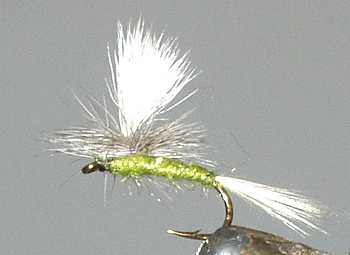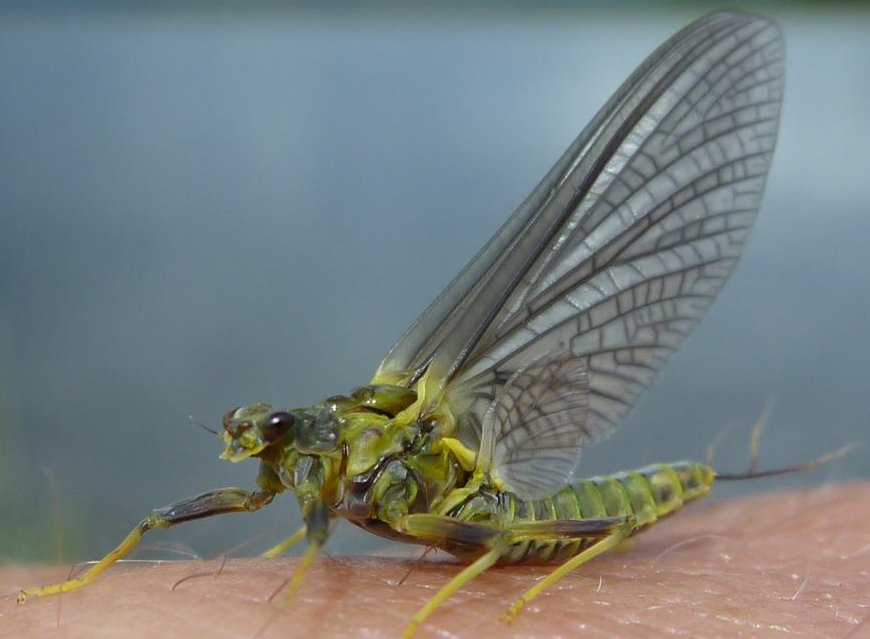Blue Winged Olive Parachute
The Blue Winged Olive (BWO) is just one common name used to describe some, but not all, members of the insect family groups called Baetis (pronounced beet-us) Ephemerella, Baetidae, Drunella and Diphetor.

PARACHUTE EMERGER DRY FLIES. Hook size 12 14 16 18 20 24 - $US each
Other names for the BWO include Bluewing, Tiny Olives, Iron Blue Dun, Iron Blue Quill, Little Slate Winged Olive, Little Slate Winged brown quill, Tiny Western Olive and Little Western Iron Blue Quill. There are many species of Blue Winged Olive mayflies. There are 153 species currently listed for North America. There is often confusion among fly fishermen because the species are difficult to distinguish. One fisherman will report success fishing a great hatch of Blue Winged Olives another on the same river will be discussing the pattern he used to imitate a Little Slate Winged Olive hatch. Quite often they are discussing the same insect. It is very difficult to distinguish one species from another. Part of the reason for identification confusion is that the scientific names for major hatches of Baetis have changed recently. But who cares what the scientific name of a sub species of mayfly is. The trout do not care. To them food is food what ever it is called.
When the trout are taking these early season mayfly, getting the size right matters more than an exact imitation. Hatches begin as early as February and continue until November. Those fly fishermen that only pick up their rod in the late spring and summer months really miss some fine fishing. Hatches normally start just after lunch. Search out back-eddies on the river. This is where I normally find blue-winged olive circle endlessly around and around. I think they like the air currents and this is where you will find the trout ready to suck them down. This fly also works well in slow run stretches of water. Use your eyes and hunt the swarms. Look out for airborne insect eating birds like swallows feasting on or near the water surface.

Blue Winged Olive mayflies imitations can catch trout throughout the flyfishing season. The disadvantage is that you have to carry a variety of hook sizes as one Blue Winged Olive will emerge in the morning and needs a hook size 12 BWO fly whilst another emerges at dusk and requires a hook size 20 fly. The presence of rising trout gently sipping something from the water's surface with no duns visible on the water generally means that the trout are taking the suspended nymphs and emerging duns. The Pheasant Tail Nymph and Gold Ribbed Hare's Ear nymphs are ideal imitations for the blue-winged olive's early stages. Drift them near the bottom any day between September to April that is if your part of the world is not covered in ice. When it is hatching time the emerging duns have to wait in the water surface for about a minute for their wings to dry. Trout love this time of the year as it is easy pickings. Try a Shipman’s Buzzer, Suspender buzzer, Klinkhammer or Parachute fly to mimic these emerging duns
WATER TEMPERATURE AND THE BLUE WINGED OLIVE
Changes in water temperature certainly play a part in trout behaviour. Many anglers are confused about what effect it has on feeding trout. Generally speaking they are more tolerant of cold water than warm water conditions. When water temperatures rise in spring the activity of the invertebrates they feed upon increases. If you get an early warm spring then the mayfly hatches may be early. If you have a prolonged cold spell they will be late. Rivers, lochs, and lakes that are feed by snow melting on the hills and mountains will have the last mayfly hatches of the region due to the cold temperature of the water. Trout become more active with an increase in water temperature as they follow their food up to the surface. You will have to adjust the depth you present your flies at match the depth that the fish are feeding in by using droppers at different heights and adjusting the length of your leader. Once you find fish at a certain level keep your flies at that depth.
Take note of what is happening in your local environment. Has it suddenly gone overcast? Has a cold wind started to blow across the water? If yes the trout will move lower in the water. If it becomes warmer again they may swim nearer the surface to search for food. You have to be ready to adjust your technique. Too often I hear fishermen telling their mates in the pub that they just do not know what happened. One moment the trout were biting and then suddenly they stopped. I have to stop myself interrupting and giving them a lecture. I have done that a few times and got no thanks. Some people don’t like to be exposed as wanting in their knowledge of their favourite sport.
Brown trout often become dormant in the winter when the water temperature is around 4 degrees Celsius. Grayling continue to remain active and bottom feed. On the same stretch of water in the summer you will find that the trout are the most active feeders. In the winter you will find that most of your takes will be grayling. If you happen to be fishing in the winter when you are blessed with an unseasonal sunny day it only takes a small rise in the temperature to trigger a hatch of blue winged olives and a sudden increase in trout activity. This happened to me last November on the chalk-rivers of southern England. I was really annoyed with myself as I did not pack any olive dry flies in my tackle bag. The sudden emergence of the sun was unexpected as it had not been included in the weather forecast the day before.
In the hot summer months the amount of dissolved oxygen in the warm water decrease. Fish become distressed. They have difficulty breathing and seek cold water at lower depths where they try to conserve energy and rarely feed. If you are fishing still water where an aerator is being used to help oxygenate the water on hot days trout will often be found congregating in shoals around the device. The same effect can be observed where a feeder stream tumbles into a lake, loch or reservoir or a water gate has been opened to allow water to enter the main system.
Fly Fishing books

